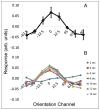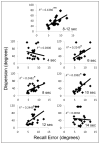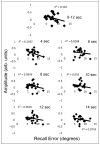A neural measure of precision in visual working memory
- PMID: 23469889
- PMCID: PMC4041615
- DOI: 10.1162/jocn_a_00357
A neural measure of precision in visual working memory
Abstract
Recent studies suggest that the temporary storage of visual detail in working memory is mediated by sensory recruitment or sustained patterns of stimulus-specific activation within feature-selective regions of visual cortex. According to a strong version of this hypothesis, the relative "quality" of these patterns should determine the clarity of an individual's memory. Here, we provide a direct test of this claim. We used fMRI and a forward encoding model to characterize population-level orientation-selective responses in visual cortex while human participants held an oriented grating in memory. This analysis, which enables a precise quantitative description of multivoxel, population-level activity measured during working memory storage, revealed graded response profiles whose amplitudes were greatest for the remembered orientation and fell monotonically as the angular distance from this orientation increased. Moreover, interparticipant differences in the dispersion-but not the amplitude-of these response profiles were strongly correlated with performance on a concurrent memory recall task. These findings provide important new evidence linking the precision of sustained population-level responses in visual cortex and memory acuity.
Figures






References
Publication types
MeSH terms
Substances
Grants and funding
LinkOut - more resources
Full Text Sources
Other Literature Sources

